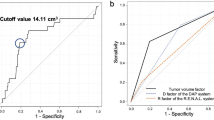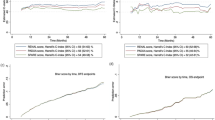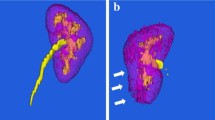Abstract
Purpose
We analyzed radiographic parameters describing anatomic features of renal tumors to identify preoperative characteristics that could help predict long-term decline in renal function following partial nephrectomy.
Methods
We retrospectively reviewed the records of 194 consecutive patients who underwent partial nephrectomy from January 2006 to March 2009 and analyzed a cohort of 53 patients for whom complete clinical, radiographic, and operative information was available. Computed tomography images were reviewed by a single radiologist. Radiographic criteria for describing renal tumor size and location included diameter, volume, endophytic properties, proximity to collecting system, anterior/posterior location, location relative to polar lines, and R.E.N.A.L. nephrometry score. Postoperative estimated glomerular filtration rate was calculated using the MDRD study group equation with serum creatinine at last follow-up.
Results
The median preoperative and postoperative GFR values were 75 (IQR 65–97) and 66 (IQR 55–84) mL/min/1.73 m2, respectively. At a median follow-up of 38 months, the median percentage decrease in GFR was 12%. On univariate analyses, tumor diameter (P = 0.002), tumor volume (P < 0.0001), nearness of tumor to collecting system (P = 0.017), and location relative to polar lines (P = 0.017) were associated with percentage decrease in GFR. Furthermore, higher R.E.N.A.L. nephrometry score was also associated with poorer renal functional outcomes following partial nephrectomy (P = 0.019).
Conclusions
Anatomic features of renal tumors defined by preoperative radiographic characteristics correlate with the degree of renal functional decline after partial nephrectomy. Identification of these parameters may assist in patient counseling and clinical decision making following partial nephrectomy. Validation in larger prospective studies is necessary.
Similar content being viewed by others
Abbreviations
- ASA:
-
American Society of Anesthesiologists
- BMI:
-
Body mass index
- EBL:
-
Estimated blood loss
- eGFR:
-
Estimated glomerular filtration rate
- GFR:
-
Glomerular filtration rate
- IQR:
-
Interquartile range
- MDRD:
-
Modification of Diet in Renal Disease
- PN:
-
Partial nephrectomy
- RCT:
-
Renal cortical tumor
- RN:
-
Radical nephrectomy
References
Jemal A, Siegel R, Xu J, Ward E (2010) Cancer statistics. CA Cancer J Clin 60:277–300
Russo P (2000) Renal cell carcinoma: presentation, staging, and surgical treatment. Semin Oncol 27:160–176
Lau WK, Blute ML, Weaver AL, Torres VE, Zincke H (2000) Matched comparison of radical nephrectomy vs nephron-sparing surgery in patients with unilateral renal cell carcinoma and a normal contralateral kidney. Mayo Clin Proc 75:1236–1242
Fergany AF, Hafez KS, Novick AC (2000) Long-term results of nephron sparing surgery for localized renal cell carcinoma: 10-year followup. J Urol 163:442–445
McKiernan J, Simmons R, Katz J, Russo P (2002) Natural history of chronic renal insufficiency after partial and radical nephrectomy. Urology 59:816–820
Sorbellini M, Kattan MW, Snyder ME, Hakimi AA, Sarasohn DM, Russo P (2006) Prognostic nomogram for renal insufficiency after radical or partial nephrectomy. J Urol 176:472–476 (discussion 6)
Levey AS, Perrone RD, Madias NE (1988) Serum creatinine and renal function. Annu Rev Med 39:465–490
K/DOQI clinical practice guidelines for chronic kidney disease: evaluation, classification, and stratification. Am J Kidney Dis 39:S1–S266 (2002)
Levey AS, Bosch JP, Lewis JB, Greene T, Rogers N, Roth D (1999) A more accurate method to estimate glomerular filtration rate from serum creatinine: a new prediction equation. Modification of Diet in Renal Disease Study Group. Ann Intern Med 130:461–470
Huang WC, Levey AS, Serio AM et al (2006) Chronic kidney disease after nephrectomy in patients with renal cortical tumours: a retrospective cohort study. Lancet Oncol 7:735–740
Malcolm JB, Bagrodia A, Derweesh IH et al (2009) Comparison of rates and risk factors for developing chronic renal insufficiency, proteinuria and metabolic acidosis after radical or partial nephrectomy. BJU Int 104:476–481
Go AS, Chertow GM, Fan D, McCulloch CE, Hsu CY (2004) Chronic kidney disease and the risks of death, cardiovascular events, and hospitalization. N Engl J Med 351:1296–1305
Weight CJ, Larson BT, Fergany AF et al (2010) Nephrectomy induced chronic renal insufficiency is associated with increased risk of cardiovascular death and death from any cause in patients with localized cT1b renal masses. J Urol 183:1317–1323
Campbell SC, Novick AC, Belldegrun A et al (2009) Guideline for management of the clinical T1 renal mass. J Urol 182:1271–1279
Kutikov A, Uzzo RG (2009) The R.E.N.A.L. nephrometry score: a comprehensive standardized system for quantitating renal tumor size, location and depth. J Urol 182:844–853
Ficarra V, Novara G, Secco S et al (2009) Preoperative aspects and dimensions used for an anatomical (PADUA) classification of renal tumours in patients who are candidates for nephron-sparing surgery. Eur Urol 56:786–793
Simmons MN, Ching CB, Samplaski MK, Park CH, Gill IS (2010) Kidney tumor location measurement using the C index method. J Urol 183:1708–1713
Russo P, Jang TL, Pettus JA et al (2008) Survival rates after resection for localized kidney cancer: 1989–2004. Cancer 113:84–96
Barlow LJ, Korets R, Laudano M, Benson M, McKiernan J (2010) Predicting renal functional outcomes after surgery for renal cortical tumours: a multifactorial analysis. BJU Int 106:489–492
Scherr DS, Ng C, Munver R, Sosa RE, Vaughan ED Jr, Del Pizzo J (2003) Practice patterns among urologic surgeons treating localized renal cell carcinoma in the laparoscopic age: technology versus oncology. Urology 62:1007–1011
Russo P (2006) Open partial nephrectomy: an essential contemporary operation. Nat Clin Pract Urol 3:2–3
Jeldres C, Bensalah K, Capitanio U et al (2009) Baseline renal function, ischaemia time and blood loss predict the rate of renal failure after partial nephrectomy. BJU Int 103:1632–1635
Lane BR, Babineau DC, Poggio ED et al (2008) Factors predicting renal functional outcome after partial nephrectomy. J Urol 180:2363–2368 (discussion 8–9)
Song C, Bang JK, Park HK, Ahn H (2009) Factors influencing renal function reduction after partial nephrectomy. J Urol 181:48–53 (discussion 4)
Pettus JA, Sharp DS, Yossepowitch O et al (2007) Tumor location does not affect long-term renal function after partial nephrectomy. Urology 69:1059–1063
Samplaski MK, Hernandez A, Gill IS, Simmons MN (2010) C-index is associated with functional outcomes after laparoscopic partial nephrectomy. J Urol 184:2259–2263
Anavekar NS, McMurray JJ, Velazquez EJ et al (2004) Relation between renal dysfunction and cardiovascular outcomes after myocardial infarction. N Engl J Med 351:1285–1295
Lane BR, Demirjian S, Weight CJ, Larson BT, Poggio ED, Campbell SC (2010) Performance of the chronic kidney disease-epidemiology study equations for estimating glomerular filtration rate before and after nephrectomy. J Urol 183:896–901
Conflict of interest
The authors declare that they have no conflict of interest.
Author information
Authors and Affiliations
Corresponding author
Rights and permissions
About this article
Cite this article
Cha, E.K., Ng, C.K., Jeun, B. et al. Preoperative radiographic parameters predict long-term renal impairment following partial nephrectomy. World J Urol 31, 817–822 (2013). https://doi.org/10.1007/s00345-011-0694-z
Received:
Accepted:
Published:
Issue Date:
DOI: https://doi.org/10.1007/s00345-011-0694-z




